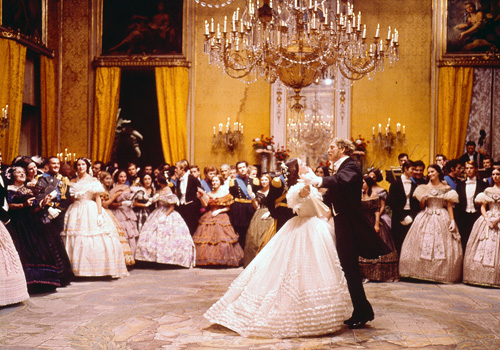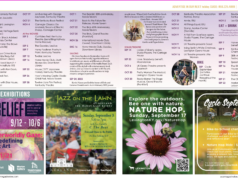by Raj Ranade
A big budget is no guarantee that a movie will look good – 200 million dollars couldn’t stop Battleship from looking like the offspring of a Hasbro commercial and a Miller Lite billboard. And as the gorgeous Moonrise Kingdom proved with only $16 million, the opposite isn’t true either. But a big budget in the hands of a true artist is something magnificent (and increasingly rare) indeed, and it’s why Luchino Visconti’s 1963 classic The Leopard demands to be seen on a big screen (like the one at the Kentucky Theater on Wednesday, September 5th).
Every frame of this film, about a family of Italian nobles caught in the midst of a revolution, is a marvel not just of painterly composition but of pathological attention to detail. For the shooting of a battle scene in the streets of Sicily, Visconti demanded that the uniforms of every extra be soaked in tea, dried in the sun, and buried in soil before being worn. Later, during the filming of the palace ball scene that makes up most of the film’s last hour, Visconti demanded fresh flowers be placed in each room daily – regardless of whether the room was actually being filmed that day. The gilded halls and resplendent finery that dominate this film may all seem like a bit much – which is part of the point.
Visconti’s film centers on the Prince of Salina (Burt Lancaster), a 19th century nobleman whose power and influence are threatened as a democratic revolution turns the independent monarchy of Sicily into part of a unified Italian state. Around him, his fellow elites scramble for a place in the new order – his nephew Tancredi (Alain Delon) shifts nimbly with political winds, joining the revolutionary army and jumping from faction to faction as they jockey for power. “For things, to remain the same, everything must change,” he tells his uncle, and to secure the fortunes of his family, the Prince attempts to marry off his nephew to the beautiful daughter (Claudia Cardinale) of a loutish, newly powerful local mayor. But though he sees the necessity of change, the Prince cannot bring himself to enter a new political world where principles are secondary to the seizing and maintaining of power.
It’s a conflict that Visconti himself no doubt felt – the director was both a politically active Marxist and a proud descendant of the kind of nobility that the film portrays. He was a man who clearly felt wistful for the luxurious era on which he lavished so much obsessive detail – and a man who also saw the absurdity of that excess (in one great sequence where Tancredi courts his wife-to-be in an abandoned wing of the palace, the young man notes “My uncle believes a palace in which you know every room isn’t worth living”). And while Visconti no doubt saw the potential of revolution, he also knew how quickly a movement’s ideals could be perverted (watch for the scene where a poorly trained band turns the announcement of a new democratic government’s rigged election into a more literal kind of farce).
But if The Leopard is focused on the political, it also has an uncommon degree of insight about the personal. The courtship between Tancredi and his wife-to-be is flush with passion (it helps that Alain Delon and Claudia Cardinale are, by any measure, two of the most beautiful people to have ever existed), but there’s also a sharp focus on the naivete and self-servingness that is an inextricable part of their young love. And then there’s the performance by Lancaster, the swaggering American matinee idol who transmutes his roughneck physicality here into a refined, controlled elegance in every moment. And in the heart-breaking close of ths film, as he wanders through a ballroom filled with symbolic reminders of an era not long for this world, his melancholy glances become as indelible as any of large-scale extravagances in Visconti’s masterwork.










